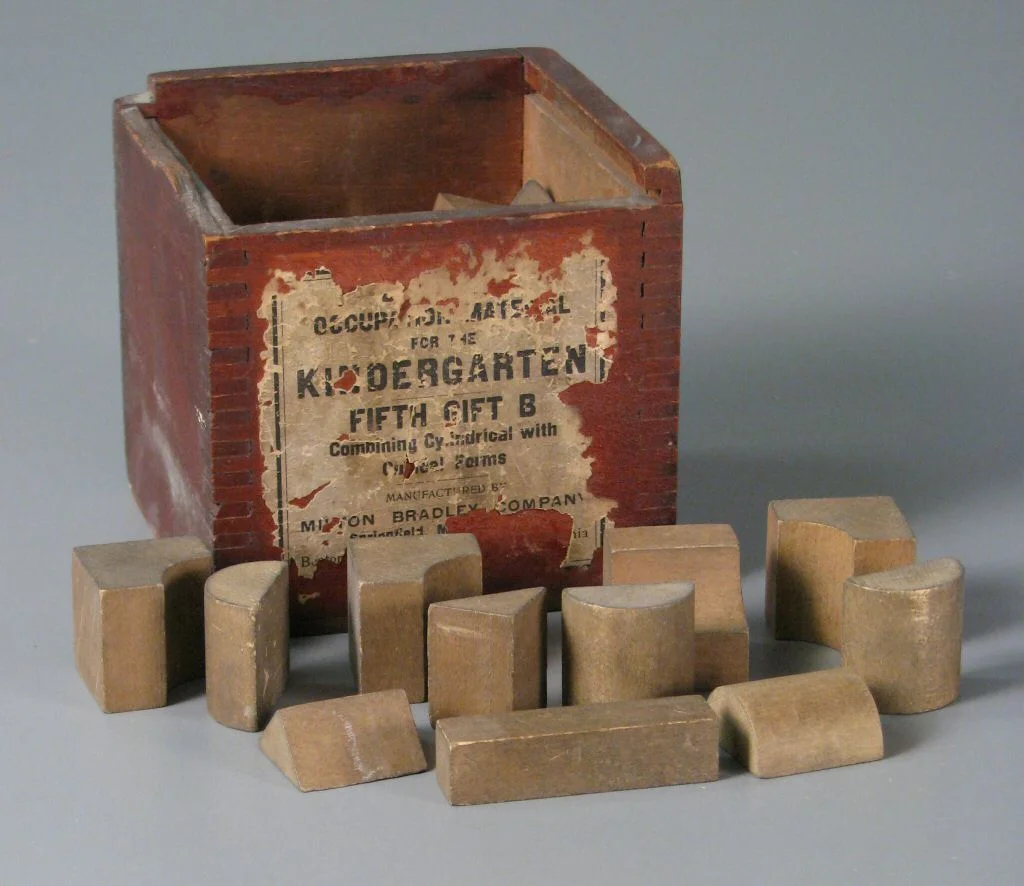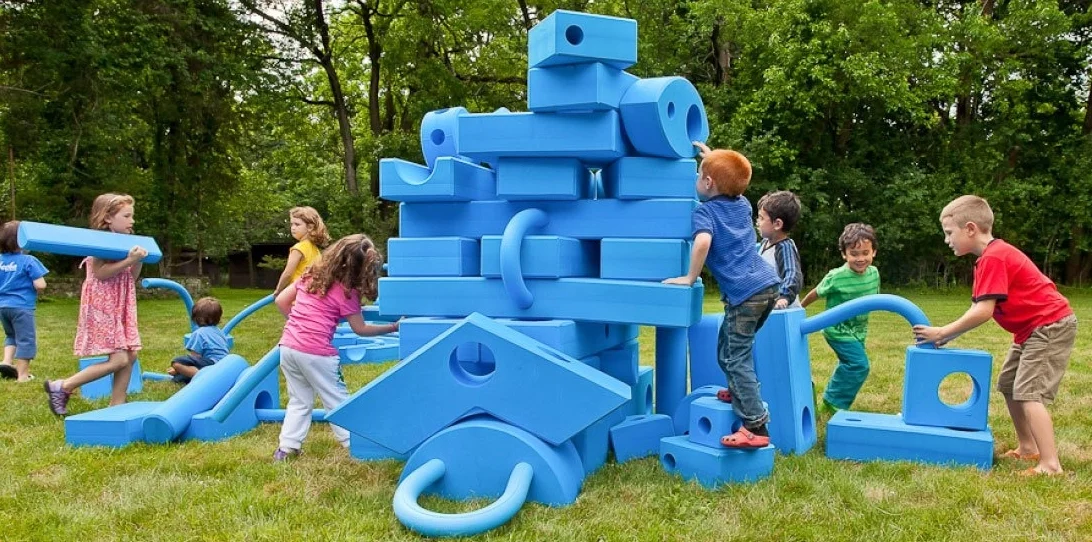005. PEDAGOGY
It all starts with a block
Written by Lily Kane
The block is an object of insistent structural simplicity, yet its historical, developmental, and cultural significance is probably greater than that of any other object a child will hold in his or her hands. Innumerable pages have been written by educators, psychologists, academics, parents, and enthusiasts on the relationship between block play and child development. Blocks offer many children their first experiences with balance, structure, artistic expression, and cause-and-effect relationships, among many other foundational lessons. For more than 150 years blocks and block play have been adapted and promoted by thought leaders of early childhood education, including Friedrich Froebel, Maria Montessori, and Caroline Pratt.
The block first appeared in modern classrooms in the mid-1840s, when German educator Friedrich Froebel formulated the concept of kindergarten through his work at the Play and Activity Institute, which he founded in 1837. He developed what he called “Froebel gifts,” a series of objects that children would receive at fixed stages of their development, ultimately collecting a complete set. Among the gifts were blocks: a single cube, followed by a cube composed of smaller, iterative cubes. The next gift explored the cube further, breaking it down into halves and quarters. Froebel gifts introduced ideas about geometry, spatial relationships, friction, and balance, as well as basic architectural building concepts, which helped their recipients understand the world around them.
Some of the most influential designers of our built world, including Buckminster Fuller, Charles Eames, and Frank Lloyd Wright, have been linked to possibly apocryphal stories about foundational lessons learned through interaction with Froebel gifts. Buckminster Fuller did attend a kindergarten heavy on Froebel philosophy, and one can certainly see how this early exposure to blocks and building may have influenced his career. Noted Eames scholar Pat Kirkham writes in Charles and Ray Eames: Designers of the Twentieth Century (MIT Press, 1995), “To what extent Froebel’s occupations or gifts were responsible for the staggering self-expression of Frank Lloyd Wright (or even Charles Eames) is not certain, but the ideas that children were naturally artistic and that art was a healthy means of self-expression were well established in the United States by the interwar period.” Certainly, the acclaimed Eames documentary Powers of Ten carries forward ideas about scale and iteration that many children first experience through block play.
Maria Montessori—an Italian educator, physician, feminist, and advocate for children with disabilities—was responsible for the next major step in the development of block use in the classroom. In the early 1900s Montessori opened a school based on her philosophy of encouraging self-reliance, discovery, and faith in a child’s innate ability to understand and apply ideas and processes. She believed that a teacher’s role was not simply to explain concepts, but to offer opportunities for children to develop problem-solving skills through their interactions with objects and with their environment. If a child is given a glass of water, for example, he or she will learn to control their movements, and should they drop and break the glass, they will learn about consequences in a safe environment as the teacher leads them through cleanup. A pillar of Montessori’s philosophy was the idea that work, such as washing dishes and sweeping, teaches children self-reliance, positive discipline, and confidence. In her book From Childhood to Adolescence, she wrote that “to teach details is to bring confusion; to establish the relationship between things is to bring knowledge.” For her blocks were objects through which children could establish mathematical and spatial relationships.
Montessori built on Froebel’s designs, introducing color and explicit mathematical exercises. Her iconic Pink Tower, ten stacking blocks in a pastel shade, helped children learn to differentiate size and encouraged precise coordination. The blocks must be stacked perfectly, each in the center of the one below; imperfectly stacked blocks will topple and become damaged. The Brown Stairs, Red Rods, and Geometric Cabinet are similar block exercises in what Montessori called Sensorial Work, which involved using the senses to explore the environment. This methodology, although strict, remains a useful tool in the modern Montessori classroom.
As Montessori worked in Europe, unit blocks—sometimes referred to as kindergarten blocks—were brought into American classrooms and homes. Unit blocks are so simple, they are almost undesigned. A set of unit blocks is composed of fractional and geometric variations on a basic block in solid, uncolored wood. They were inspired by Froebel gifts, but they differ in not constituting a specific, scripted whole—in allowing for free-form play.
Unit blocks’ omnipresence in American homes and classrooms is due largely to the work of progressive educator Caroline Pratt. Pratt founded the City and Country School—originally called the Play School, and still revered for its progressive educational philosophy—in New York City’s Greenwich Village neighborhood in 1914. As noted on City and Country’s website, Pratt’s main goal was to develop and offer “alternatives to ‘the repression of formal education.’” One of her primary tools for liberating children from the confines of antiquated pedagogy was the unit block.
Pratt recognized that through block play children were essentially educating themselves, which not only freed teachers and parents to focus on other things, but also promoted the development of creativity and critical thinking. By compelling children to face and overcome risk, block play also helps them build confidence, and seeing the way one misplaced block can topple a tower is an excellent way for children to learn that actions have consequences. Jennifer Sunderland, an early-childhood educator and the founder of Play Lab, a preschool in Brooklyn, explains that blocks make children feel “vested in the physical world. They can topple a block tower, but they have the power to make it right again.” She adds that “a stipulation in any classroom that’s run in an egalitarian way is that unless you built it, you can’t knock it down without asking. And if you do, you have to help rebuild it, provided the builder wants you to help.” So, in addition to promoting individual understanding of action and reaction, blocks can help children learn about playing and working together.
Unit blocks are a central part of free-form play (as opposed to directed play such as assembling a Froebel gift cube, or stacking the Pink Tower perfectly in a Montessori classroom). Undirected block play encourages children to create a narrative. For example, as they build a city, they may imagine the places that compose it and the people who inhabit it. Children may also use blocks to process their anxieties about the world. After the 9/11 attacks, Sunderland notes, many block towers were built, then knocked down with blocks representing airplanes. Children use blocks as tools to understand stressful experiences in their world by recreating those experiences in controlled environments.
According to industrial designer Tucker Viemeister, "Unit blocks are ergonomically perfect, and there is a natural evolution to how kids interact with blocks that happens without forcing or guiding." Viemeister was with the Rockwell Group when David Rockwell developed the Imagination Playground, a set of blocks inspired by Froebel, Montessori, and Pratt that goes further by allowing children to create their own play space that, as noted in Imagination Playground’s mission statement, “combines all of the benefits of block play on a larger-than-life-size scale.” The blocks are easily separated and packed into a box, antiquating the notion of the traditional, fixed playground. Imagination Playground represents a seismic moment in contemporary block design, in that it is based on existing pedagogy but offers a new benefit, the ability for children to build something they can physically interact with at a much greater scale. The blocks offer children a new challenge in the calculated risk of designing something to support their weight. Imagination Playground blocks have been a success, perhaps because, as Viemeister says, “They mesh exactly with the industrial design philosophy of learning by making.”
While there aren’t as many varieties of blocks as there are pages written about them, there are many, and each offers something different to the developmental process. Imagination Playground blocks, like Lego, Lego Duplo, and Lincoln Logs, facilitate learning about complex structural building and, because they lock together, permanence.
In his new introduction to Caroline Pratt’s influential book I Learn from Children: An Adventure in Progressive Education, Ian Frazier writes, “How to bring the world and its inherent quality of instruction into the classroom? She [Pratt] thought about the problem and came up with a solution as simple as the most brilliant solutions often are: blocks.” Many educators feel free-form play is the gold standard in encouraging early learning and laying a foundation for discovery, one of the core benefits provided by blocks. Blocks are among the most intuitive tools available to children in the early phases of learning about the physical world, and they are, as Frazier suggests, a child-sized representation of the world and its many lessons. And as Caroline Pratt, who made blocks the cornerstone of her life’s work, wrote, “a lifetime is not too long to spend in learning about the world.”


















